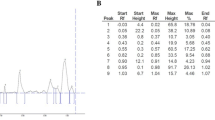Abstract
Scoparone is a major component of the shoot of Artemisia capillaris (Compositae), which has been used for the treatment of hepatitis and biliary tract infection in oriental countries. In the present study we observed that, scorparone exhibited no cytotoxic effect in unstimulated macrophages, but reduced the release of nitric oxide (NO) and prostaglandin E2 (PGE2) upon stimulation by IFN-γ/LPS or LPS. The inhibitory effects were found to be in conjuction with the suppression of inducible nitric oxide synthase (iNOS) and cyclooxygenase-2 (COX-2) in IFN-γ/ LPS stimulated RAW 264.7 cells. Moreover, scoparone also attenuated the production of tumor necrosis factor (TNF)-α, interleukin (IL)-1β and IL-6 in LPS-stimulated RAW264.7 cells. These results suggest that scoparone decreases the production of the inflammatory mediators such as NO and PGE2 in macrophages by inhibiting iNOS and COX-2 expression.
Similar content being viewed by others
References
Barnes, P. J. and Karin, M., Nuclear factor-kappaB; a pivotal transcription factor in chronic inflammatory diseases.N. Engl. J. Med., 336, 1066–1071 (1997).
Becherel, P. A., Chosidow, O., and LeGoff, L., Inducible nitric oxide synthase and proinflammatory cytokine expression by human keratinocytes during acute urticaria.Mol. Med., 3, 686–694 (1997).
Chang, H. M. and But, P. P. H., Pharmacology and applications of Chinese materia medica.World Scientific: Singapore; 867–871 (1987).
Dinarello, C. A., Cytokines as endogenous pyrogens.J. Infect. Dis., 179, S294–304 (1999).
Feldmann, M., Brennan, F. M., and Maini, R. N., Role of cytokines in rheumatoid arthritis.Annu. Rev. immunol., 14, 397–440 (1999).
Hagan, P., Poole, S., and Bristow, A. F., Endotoxin-stimulated production of rat hypothalamic interleukin-1betain vivo andin vitro, measured by specific immunoradiometric assay.J. Mol. Endocrinol., 11, 31–36 (1993).
Harada, A., Sekido, N., and Akahoshi, T., Essential involvement of interleukin-8 (IL-8) in acute inflammation.J. Leukocyte. Biol., 56, 559–564 (1994).
Huang, H. C., Chu, S. H., and Chao, P. D., Vasorelaxants from Chinese herbs, emodin and scoparone, possess immunosuppressive properties.Eur. J. Pharmacol., 198, 211–213 (1991).
Huang, H. C., Huang, Y. L., and Chang, J. H., Possible mechanism of immunosuppressive effect of scoparone (6,7-dimethoxycoumarin).Eur. J. Pharmacol., 217, 143–148 (1992a).
Huang, H. C., Lee, C. R., and Weng, Y. L, Vasodilator effect of scoparone (6,7-dimethoxycoumarin) from a Chinese herb.Eur. J. Pharmacal., 218, 123–128 (1992b).
Kang, T. H., Pae, H. O., and Jeong, S. J., Scopoletin: an inducible nitric oxide synthesis inhibitory active constituent fromArtemisia feddei. Planta. Med., 65, 400–403 (1999).
Kotake, Y., Sang, H., and Miyajima, T., Inhibition of NF-kB, iNOS mRNA, COX-2 mRAN, and COX catalytic activity by phenyl-N-tert-butylnitrone (PBN).Biochim. Biophys. Acta, 1448, 77–84 (1998).
Lee, S. H., Soyoola, E., and Chanmugam, P., Selective expression of mitogen-inducible cycloocygenase in macrophages stimulated with lipopolysaccharide.J. Biol. Chem., 267, 25934–25938 (1992).
Mannel, D. N. and Echtenacher B., TNF in the inflammatory response.Chem. Immunol., 74, 141–161 (2000).
Michel, T., Xie, Q. W., and Nathan, C., Molecular biological analysis of nitric oxide synthases.Methods in Nitric Oxide Rsearch, Feelisch, M. and Stamler, J. S. (eds.). John Wiley & Sons, New York, 161–175 (1995).
Mojena, M., Hortelano, S., Castrillo, A., Diaz-Guerra, M. J., Garcia-Barchino, M. J., Saez, G., and Bosca, L., Protection by nitric oxide against liver inflammatory injury in animals carrying a nitric oxide synthase-2 transgene.FASEB. J., 15, 583–585 (2001).
Moncada, S., Palmer, R. M., and Higgs, E. A., Nitric oxide: physiology, pathophysiology and pharmacolygy.Pharmacol. Rev., 43:109–142 (1991).
Nathan, C., Inducible nitric oxide synthase: what difference does it make?J. Clim. Invest., 100, 2417–2423 (1997).
Penglis, P. S., Cleland, L. G., and Demasi, M., Differential regulation of prostaglandin E2 and thromboxane A2 production in human monocytes: implications for the use of cyclooxygenase inhibitors.J. Immuunol., 165, 1605–1611 (2000).
Roshak, A. K., Jackson, J. R., and McGough, K., Manipulation of distinct NF-kB proteins alters interleukin-1β-induced human rheumatoid synovial fibroblast prostaglandin E2 formation.J. Biol. Chem., 271, 31496–31501 (1996).
Sautebin, L., Prostaglandins and nitric oxide as molecular targets for anti-inflammatory therapy.Fitoterapia., 71, S48–57 (2000).
Smith, W. L., Garavito, R. M., and Dewitt, D. L., Prostaglandin endoperoxide H synthases (cyclooxygenases)-1 and -2.J. Biol. Chem., 271, 33157–33160 (1996).
Straub, R. H., Linde, H. J., and Mannel, D. N., A bacteria-induced switch of sympathetic effector mechanisms arguments local inhibition of TNF-alpha and IL-6 secretion in the spleen.FASEB. J., 14, 1380–1388 (2000).
Valenciennes, E., Smadja, J., and Conan, J. Y., Screening for biological activity and chemical composition ofEuodia borbonica var.borbonica (Rutaceae), a medicinal plant in Reunion Island.J. Ethnopharmacol., 64, 283–288 (1999).
Wheeler, A. P. and Bernard, G. R., Treating patients with severe sepsis.N. Engl. J. Med., 340, 207–214 (1999).
Xie, Q. W., Kashiwabara, Y., and Nathan, C., Role of transcription factor NF-kB/Rel in induction of nitric oxide synthase.J. Biol. Chem., 269, 4705–4708 (1994).
Yamashita, T., Kawashima, S., and Ohashi, Y., Resistance to endotoxin shock in transgenic mice overexpressing endothelial nitric oxide synthase.Circulation. 100, 931–937 (2000).
Author information
Authors and Affiliations
Rights and permissions
About this article
Cite this article
Jang, S.I., Kim, YJ., Lee, WY. et al. Scoparone from artemisia capillaris inhibits the release of inflammatory mediators in RAW 264.7 cells upon stimulation cells by interferon-γ plus LPS. Arch Pharm Res 28, 203–208 (2005). https://doi.org/10.1007/BF02977716
Received:
Issue Date:
DOI: https://doi.org/10.1007/BF02977716




